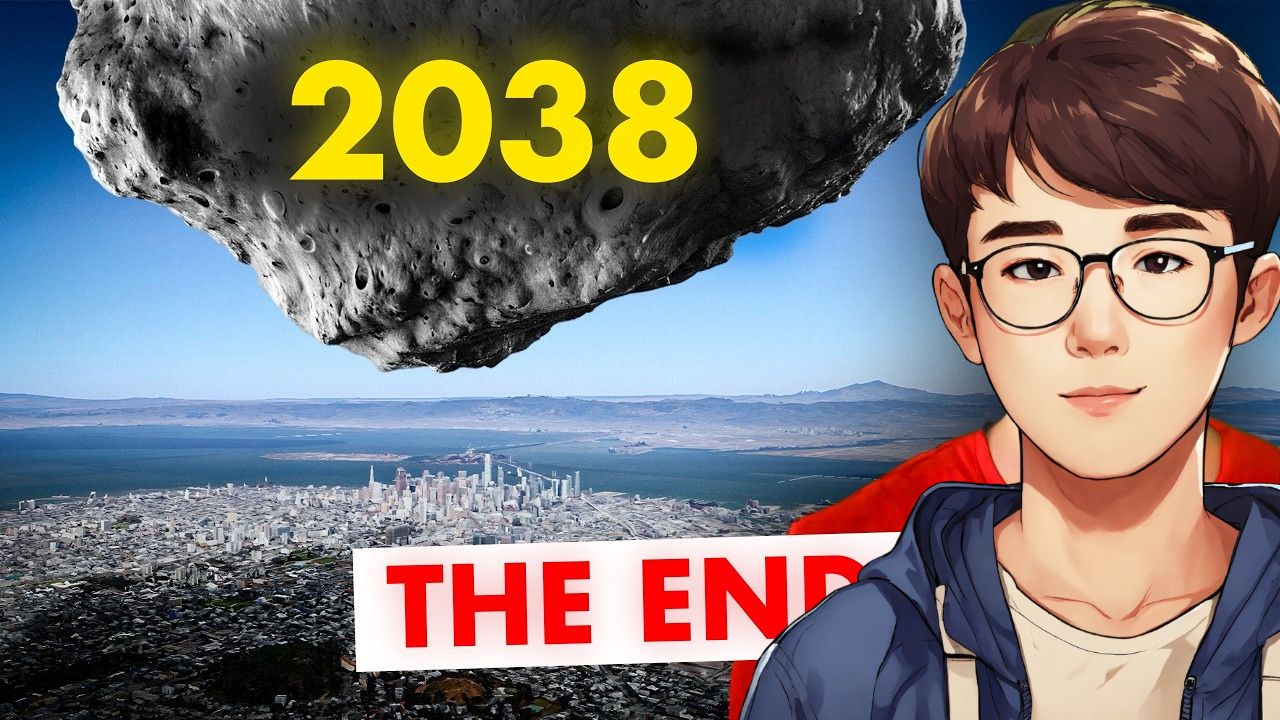Will this Asteroid DESTROY Earth in 2038? | Dhruv Rathee
Hello friends! On 13th April, 2029, a huge asteroid named Apophis, more than 1,000 feet in diameter, will pass by the Earth at a close proximity. If it were to hit the Earth, it could bring about devastation unlike anything seen before in human history. Compared to the bomb dropped on Hiroshima, this would release 1 million times more energy. There would be tsunami waves hundreds of meters high, wiping out entire cities.
However, on 12th July, 2038, another asteroid could collide with Earth. Some sources claim a 72% chance of this collision. NASA has issued alerts and started planetary defense exercises. Even ISRO’s Chief has warned about the possibility of extinction and the option of migrating to Mars. How much truth is there in such news? Which asteroids pose the most danger to Earth, and what are NASA’s plans? Let’s understand all these in depth.
Asteroids, also called planetoids, are essentially huge pieces of rock orbiting in space. They can range from 10-20 meters to 100-200 kilometers in diameter. The smallest discovered asteroid is just 2 meters wide, while the largest, Ceres, has a diameter of 940 kilometers. Most asteroids in our solar system are found in the Asteroid Belt between Mars and Jupiter, housing millions of asteroids.
The textbook drawing of the asteroid belt may look crowded, but in reality, the average distance between any two asteroids is more than 1 million kilometers. Sometimes, these asteroids move away from this belt and get close to Earth, becoming Near Earth Objects (NEOs). NEOs aren’t just asteroids; they can be comets, meteors, meteorites, and meteoroids. Though all are essentially pieces of rock moving through space, they are defined differently.
Asteroids are made of rocks and metals, while comets are composed of ice, rocks, and dust, earning the nickname “Dirty Snowballs.” Comets are found in the Kuiper belt, far from the Sun. When a comet moves through space, it often has a visible tail, unlike asteroids. Comets are typically larger, with diameters of 1-10 kilometers, and are easily seen with the naked eye when passing by Earth.
In terms of danger, comets pose a greater risk than asteroids. First, they travel at twice the speed of asteroids, and second, the warning time is shorter. A comet could suddenly appear and collide with Earth, potentially without much warning. This scenario was depicted in the film “Don’t Look Up,” where a comet was predicted to collide with Earth in just six months, and we saw how governments and space agencies reacted.
A meteoroid is a small piece of an asteroid or comet. When a meteoroid enters Earth’s atmosphere, it becomes a meteor. As it burns quickly, it creates a streak of light, often called a shooting star. If the meteor survives and lands on Earth, it’s called a meteorite. These distinctions are important, but what’s crucial are the NEOs, asteroids, and comets that pass close to Earth and pose a significant risk.
This concern is justified, as it happened to the dinosaurs 66 million years ago. If they could go extinct, so could we. But before delving into the danger, it’s important to note that news about a 2038 asteroid strike is completely fake. If you get your news from social media, it’s better to follow credible sources like The Hindu, Indian Express, Scroll.in, and mainstream news sites.
For example, Times of India published a clickbait headline about NASA warning of a 72% chance of an asteroid impact. However, the article clarified that this was a hypothetical exercise conducted by NASA to assess the planet’s preparedness against an asteroid impact. Over 100 experts from organizations like NASA, the European Space Agency, and the UN participated in this mock test.
The date of 2029 is not hypothetical. The Apophis asteroid, over 1,000 feet in diameter, does exist and will pass by Earth on 13th April 2029, just 30,000 km away. This is closer than some geostationary satellites. NASA has released a video showing the asteroid’s path, and in five years, you won’t need a telescope to see it. But the chances of Apophis colliding with Earth are zero.
When Apophis was discovered in 2004, initial observations suggested a 2.7% chance of collision with Earth in 2029, causing global concern. Even though this 2.7% chance wasn’t significant, the potential consequences were terrifying, leading to its nickname, the “City Killer.” However, further observations have since confirmed a 0% chance of collision in the next 100 years.
This asteroid has now been removed from the risk list of Near-Earth Objects. Space agencies maintain a Risk List of the most dangerous asteroids, which includes data on possible collisions, impact dates, probabilities, and asteroid diameters. For example, the European Space Agency’s website features a list of potential asteroid and comet collisions, showing how accurate our predictions have become thanks to data science.
Data science has revolutionized various fields, including space exploration, finance, and healthcare, making it a lucrative career option. If you’re interested in upskilling yourself, Scaler, an online tech-learning platform, offers programs in software development, programming, and data science, taught by industry experts. They provide daily learning sessions and real-world case studies, with a proven track record of helping learners secure placements in top tech companies.
Now, back to the Risk List. At #1 is the 2023VD3 asteroid, discovered in 2023. This asteroid, 11-24 meters wide, might collide with Earth on 8th November 2034, with a 0.25% chance of impact. Despite its small size, it is still dangerous. A similar event occurred in 2013 when the Chelyabinsk meteor exploded above Russia, injuring many people and damaging buildings, though no lives were lost.
At #2 is the 1979XB asteroid, which is much larger, with a diameter of 400-900 meters. It could potentially collide with Earth on 12th December 2056, but the probability is extremely low at 0.00002%. Despite this, its size makes it a concern. At #3 is asteroid 2008JL3, with a diameter of 23-50 meters and a potential impact date of 1st May 2027. Its probability of collision is 0.01%.
These space agencies are doing a great job of tracking asteroids and comets, but there’s always a risk of discovering new threats in the future. Comets, in particular, don’t have predictable trajectories, so we may not have much warning. If a comet were discovered tomorrow with the potential to collide with Earth, we might only have 6-7 years to prepare.
Earth’s detection systems, like LINEAR, CSS, PAN STARRS, and ATLAS, are quite advanced. LINEAR, a project started in 1996, discovers over 10,000 objects yearly, with 65% of all new asteroids identified by this system. CSS, established by the University of Arizona, uses precise measurements to predict the exact time and location of asteroid impacts, as seen with a 4-meter asteroid in 2008.
PAN STARRS, located in Hawaii, uses the world’s largest digital cameras to find asteroids, capturing images with 1.4 billion pixels. ATLAS, also in Hawaii, serves as a final alert system, scanning the sky twice nightly to detect any undetected threats. Despite these systems, small meteors can sometimes remain undetected, like the Chelyabinsk meteor in 2013.
NASA emphasizes the importance of a Civil Defence Component for scenarios involving small asteroids or meteors. International coordination and timely activation of disaster management plans are crucial. But what if a large asteroid is on a collision course with Earth? There are three strategies: Kinetic methods, Slow Push and Pull methods, and Nuclear methods.
The Kinetic Method involves sending a spacecraft to collide with the asteroid, changing its orbit. This method was successfully tested in NASA’s Double Asteroid Redirection Test (DART) in 2022, where a spacecraft collided with the Dimorphous asteroid, altering its orbit. China’s National Space Agency plans a similar experiment in 2025 with a 30-meter-wide asteroid.
The Slow Push and Pull method involves gradually changing the asteroid’s orbit using solar energy. A spacecraft could focus the Sun’s rays on the asteroid, causing it to vaporize and release gas, creating a small thrust that changes its orbit. This method, while effective, is still in development, as it poses technical challenges.
The Nuclear Method involves sending a spacecraft with nuclear bombs to destroy the asteroid. While it sounds like something out of a movie, it may be considered for asteroids over 10 kilometers wide, like the one that caused the dinosaurs’ extinction. However, this method could create legal, international, and geopolitical issues, and there’s a risk of uncontrolled fragments colliding with Earth.
NASA’s recent mock test discussed these points in detail, exploring how to deal with a large asteroid on a collision course with Earth. While Earth’s defense systems are robust, there’s always room for improvement, especially in scenarios involving unforeseen threats.


Серверы HP для стартапов и небольших компаний
серверы hp купить http://www.kupit-server-hp.ru/ .